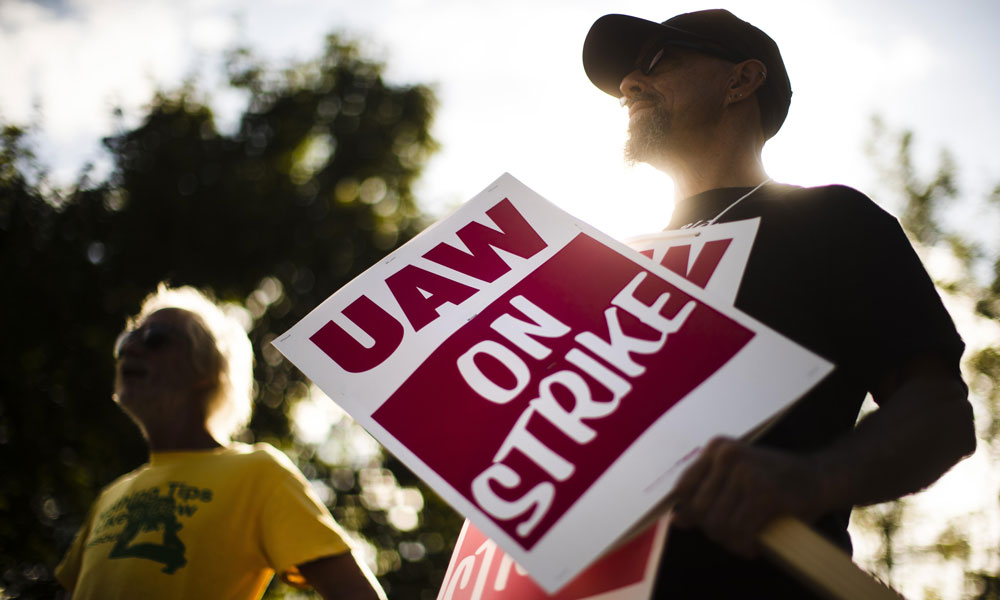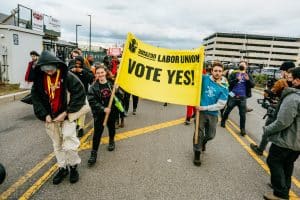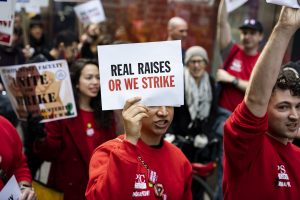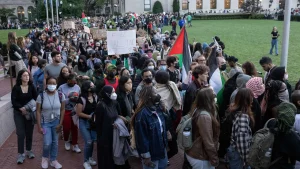When the United Auto Workers (UAW) began a nationwide strike against General Motors on September 15, 2019, they hoped to regain lost ground after decades of concessions. Auto workers have experienced declining quality of life year after year, under both Republican and Democratic administrations. While Trump’s claim to “make America great again” through xenophobic scapegoating and isolationism has failed to bring back industrial jobs that pay a living wage, it was the Obama administration that attacked the UAW in 2009 by demanding concessions in exchange for the great auto bailout (totaling $81 billion from 2008 to 2014). “They got bailed out, we got sold out!” was a common refrain on the picket lines, and workers vowed to fight back.
Get your copy of Left Voice magazine, which includes this article.
The forty-day GM strike got off to an ominous start. Corruption scandals rocked the union, as the FBI raided the homes of top UAW officers days before the walkout. Many workers wondered to what extent the strike was an attempt by union leaders to save face. When two thousand Aramark workers employed in GM facilities began their own strike one day before the nationwide GM shutdown, UAW leadership shamefully instructed auto workers to cross the Aramark workers’ picket line.
When almost fifty thousand UAW members walked off the job the next day, however, workers began to feel their massive strategic power in the world economy. From upstate New York to Texas, the billion-dollar General Motors company ground to a halt. Teamsters vowed that their members would not move any struck GM vehicles, while Ford and Fiat Chrysler employees joined GM workers on the picket lines. A slew of worker-controlled Facebook groups appeared, allowing union members to communicate with each other across the country. Auto workers in Brazil, Mexico, and Korea sent messages of solidarity.
By the third week, the fight at GM became the longest auto strike in the United States since 1970. Reports that GM was losing tens of millions of dollars each day did not bring a resolution any closer. Meanwhile, on the picket lines, workers confronted scabs and suffered a number of arrests. On the whole, however, workers held the line, the scabs were few and far between, and GM facilities remained closed. Ultimately, the strike would cost GM $2–4 billion.
The effects of the labor conflict began to ripple internationally. Auto manufacturing in Mexico and Canada was directly impacted by the strike, resulting in idled factories and layoffs. Mexican GM workers in the Silao production facility heroically refused to accept overtime work in a show of solidarity with GM workers in the United States. Despite the substantial impact of the strike, however, GM still posted sizable profits for the third quarter, and GM stock remained relatively stable. That the auto giant could withstand the strike and reap third-quarter profits must be understood as a result of its large stockpile of product (vehicles) and its ability to continue production outside the United States. The hapless UAW leadership, for its part, did not prepare for the strike and lacked any perspective for winning.
UAW Bureaucrats Sell Out
Before the tentative contract was brought back to membership, forty to fifty workers gathered outside the Renaissance Center hotel where the union was conducting its secret negotiations with GM. The workers drove from Lordstown, Ohio, to Detroit to demand the union refuse layoffs. “No product, no vote!” they chanted, as UAW bigwigs walked past them en route to the negotiating table. But the Lordstown workers were betrayed as soon as a tentative deal was reached; the bargaining committee had agreed to layoffs and plant closings.
As soon as it was made public, UAW members poured over the 350-page contract. Experienced workers began to conclude that the proposed agreement would be a step backward, allowing the closure of the Lordstown Assembly, Baltimore Operations, and Warren Transmissions factories. Additionally, the deal maintained the tiered structure of employment and allowed GM to increase the hiring of temps and other poorly paid workers. The UAW apparatus, for its part, used disinformation and scare tactics to push members to ratify. In one particularly shameful act of intimidation, union officials in Spring Hill, Tennessee, called the police on their own members for protesting the contract and urging a no vote. This scandal caused thousands of members to voice their disgust on Facebook.
As workers explained in posts on many Facebook groups, the contract was full of vague language and loopholes. The path to permanent status for temporary workers, for instance, required three years of consecutive employment, meaning any worker laid off for more than thirty days would lose their time. Even without the “consecutive years” loophole, however, a three-year path to permanent status was a far cry from the ninety-day probationary period that was once the norm.
The biggest “carrot” used by the company to sell the contract was a signing bonus of $11,000 for permanent workers and $4,500 for temps. But these signing bonuses will be heavily taxed and serve only as back pay for lost wages during the strike. Many senior workers observed that the best UAW contracts never had signing bonuses, whereas the worst ones often do because an incentive is necessary to secure contract ratification.
The contract failed to meet workers’ basic demands, such as an end to layoffs and plant closings, a real path to permanent status for temps, and a solid raise that would account for inflation. Instead of strengthening the union by bringing every sector up to par with “legacy workers” (those hired before 2007), the contract reinforced divisions: some workers would have pensions, others would not; some would make a solid wage of $32 an hour, while some would make half that. GM was given free rein to expand the use of multitiered, part-time, and temporary workers.
While UAW members were reading and debating the tentative agreement during the last week of the strike, many union activists began to campaign for a no vote on the contract. The Militant Worker podcast reviewed the contract and gave it a thumbs-down. A Facebook group, Autoworkers Caravan, published a “Contract Lowlights” statement that opposed the contract. A number of workers took to Facebook Live to share their thoughts. Video recording by union oppositionist Omar Guevara urging a no vote was shared over three hundred times and viewed by over fifty thousand people.
Despite the heavy-handed campaign by the union bureaucracy to push the contract ratification forward, a vocal opposition made its presence felt. The strong “vote no” campaign reflected a willingness by large sectors of GM workers to keep the strike going until key demands were met. The militancy shown by workers who refused to accept layoffs and tiered employment shows the potential for challenging the largely discredited UAW leadership and transforming the union into a militant organization for class struggle. Thus, while the tentative agreement passed with a slim majority (57 percent), representing a setback, an opening exists for workers to lead the way forward through militant, antibureaucratic organizing.
How Could the Strike Have Succeeded?
As some workers remarked on social media, it was necessary for the union to strike long enough to threaten GM’s stockpiled product. A three-month strike, for instance, could have put the squeeze on GM and compelled it to grant major concessions. Had the union’s massive $750 million strike fund been placed at the service of the membership, GM workers could have held out until victory. Instead of the paltry $250–$275 a week strike pay that workers received, the union had the funds available for each striking GM worker to have received $500 a week for thirty weeks before the fund was used up. Moreover, UAW owns billions of dollars in financial assets, including GM stock. By keeping strike pay low, the union bureaucrats succeeded in pressuring members into accepting a concessionary contract when the material conditions for victory were abundantly present. Had the UAW rank and file taken control of the struggle, the strike could have won, and an important step could have been taken toward revitalizing the entire labor movement.
The power of GM workers could have been greatly magnified, as well, by an energetic effort to spread the strike to GM facilities outside U.S. borders. While there is significant resentment within UAW ranks over production being outsourced to Mexico, the truth is that Mexican, Canadian, and other GM workers around the world are the natural allies of UAW workers. With globalized auto production now an undeniable fact, broadening the strike internationally and developing common demands among the global auto workforce is the logical next step for any struggle against the international auto bosses. So long as auto workers remain fragmented and isolated in the framework of national unionism, transnational auto corporations will continue dividing and conquering their workforce. Internationalism remains a practical, strategic imperative for building union power.
Crucial in this respect are militant pickets lines that shut down production, a willingness to strike indefinitely, adequate strike pay, and a perspective of international worker solidarity. But the most fundamental question facing workers is, who calls the shots—the rank and file or the bureaucrats? An elected strike committee representing the entire membership could democratically decide how to carry forward the strike, which tactics to employ, which demands are nonnegotiable, etc. Instead of the UAW’s top-down bureaucratic machine, mass assemblies of workers should be charged with making all important decisions democratically. Elected leaders should carry out the mandate of the assemblies, be immediately recallable, and make a worker’s wage. The self-organization of the membership is indispensable for reversing organized labor’s long decline.
The Union Bureaucracy: A Strategic Obstacle
The sellout of the GM strike did not occur in a vacuum. Across the country, labor unions have been smothered by bureaucratic leadership far removed from the membership. The UAW’s strata of well-paid functionaries is a particularly extreme case in point: union president Gary Jones rakes in a yearly salary of $200,000, while the true perks enjoyed by the top UAW officials go far beyond that. In terms of lifestyle and social outlook, the leaders of today’s unions have more in common with capitalists than the membership they ostensibly represent. Indeed, the top layers of the UAW are implicated in corruption scandals, including accepting bribes from the auto bosses.
But while the UAW tops may be particularly corrupt, the tentacles of union bureaucracies extend far across the U.S. labor movement. When the teachers’ strike wave erupted last year, it was not led by the teachers’ unions but rather by the self-organized rank-and-file. As arbitrators of class peace, most union leaderships will accept concessions long before they are willing to risk their own privileged position by organizing a militant fight. Recent examples include the quarter of a million UPS Teamsters who authorized a strike and rejected the company’s offer, only to have the Teamster leadership undemocratically declare the contract ratified. Even within unions with more leftist and democratic reputations, such as New York State Nurses Association (NYSNA) and the Professional Staff Congress (PSC), the union bureaucracy continues to betray the membership year after year.
Leadership and Program
In its early years the UAW was a major force for social change, evincing the militancy of auto workers fighting for a better world. The union was built through factory occupations and mass action, with workers sometimes facing off against the police and company thugs. At its height the UAW grew to 1.4 million members, and for many years it set the standards for quality union contracts. As many workers have remarked, the self-sacrificing UAW militants of old would be rolling in their graves if they saw the present state of affairs.
Charting a path forward, we must rekindle the best traditions of the early American labor movement for today’s context. Building an opposition movement premised on union democracy and class struggle is an important first step. In the long term, however, a rank-and-file opposition must develop a broader political response to the burning questions confronting working people. The dire threat of ecological collapse, for instance, cannot be ignored. Nor can a working-class leadership worthy of the name ignore today’s movements for equality and justice.
A militant union opposition in the auto sector would support a Green New Deal, while calling for auto production and all heavy industry to be nationalized under the control of the working class. Worker-run factories could be retooled to produce carbon-efficient means of public transportation (trains, buses), agricultural equipment that is urgently needed in the Global South (tractors, implements), and to the extent needed, personal vehicles. Given the advances in labor efficiency, a mass public works program could easily provide universal employment and drastically reduce the workweek with no loss in pay.
Further, the unity of the working class is strengthened by confronting racism, sexism, xenophobia, and other forms of oppression—in a word, showing working-class solidarity. When unarmed black people are shot dead by police, or immigrant children are locked away in detention camps, organized labor must protest.
For those of us who recognize the need to end capitalist rule, the struggle against the union bureaucracy and for workers’ self-organization are crucial steps. By reclaiming the unions as democratic fighting organizations, workers can gain the confidence to question, and eventually challenge, the rule of billionaires. In the fight for working-class power, neither of the two main political parties, Democrats and Republicans, offers a solution. Workers must shape the future ourselves.










